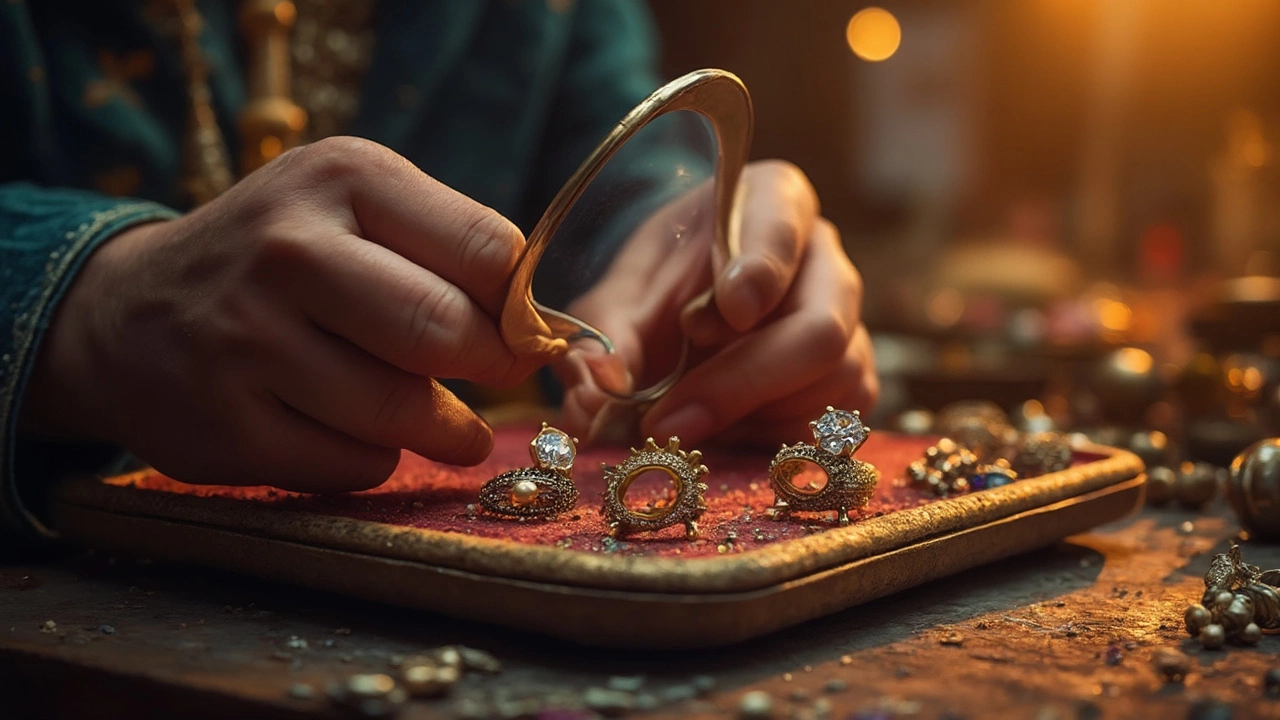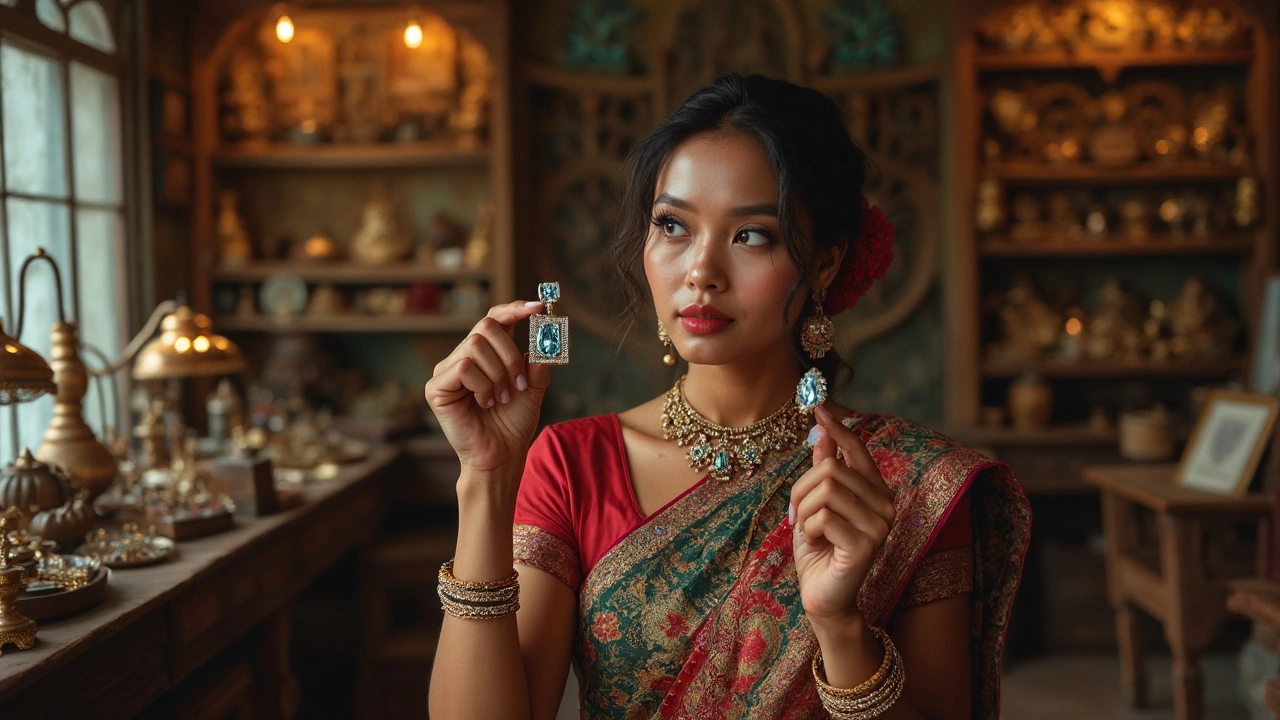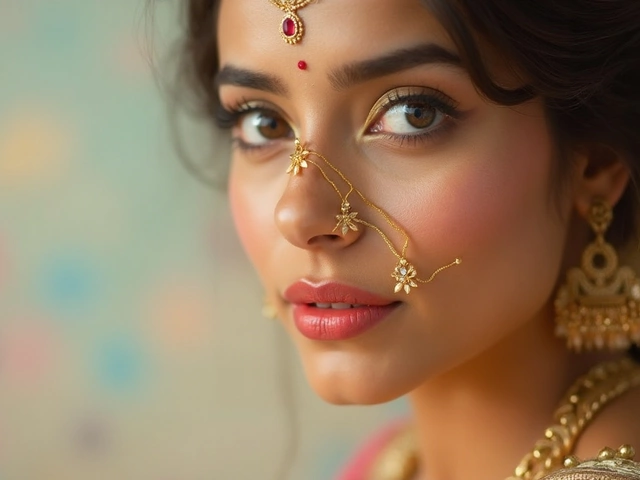
You might think spotting cubic zirconia is easy if you know what to look for, but this stone can really fool you—especially in old or vintage settings. Cubic zirconia usually appears bright, super clear, and almost too perfect. That high level of clarity is your first big clue.
Unlike natural diamonds, cubic zirconia has fewer of those tiny, random flaws called inclusions. Most CZ stones look flawless, which can be a giveaway. Have you noticed jewelry that just seems to sparkle in a sort of rainbow, flashy way? That's another sign. CZ is famous for its colorful 'fire,' especially under store lighting or sunlight. While real diamonds also sparkle, their flashes are usually more subtle and white.
- Cubic Zirconia in Antique Jewellery
- How to Tell Cubic Zirconia Apart from Diamonds
- Physical Features and Tests
- Why Cubic Zirconia Became Popular
Cubic Zirconia in Antique Jewellery
When you dig into the world of cubic zirconia and antique jewellery, it's easy to mix things up. Genuine antique pieces from before the 1970s almost never use cubic zirconia. That’s because the stuff didn’t hit the jewelry scene until after 1976, when Soviet scientists cracked the code on how to make it cheap and look like real diamonds. So if someone sells you a "Victorian" ring full of CZ stones, it’s probably a reproduction or something made much later.
You’ll see CZ a lot in vintage jewelry from the late 1970s and 1980s—that era had a big love for glitzy, flashy designs without the diamond prices. Brands jumped on this, making everything from cocktail rings to brooches and earrings using this affordable stone. Vintage dealers sometimes call these "retro" or "statement" pieces, and you’ll find CZ all over them, especially in those chunky styles that pop up at markets and online shops.
Here’s a quick reference to help spot if your piece is likely to have CZ, based on its era:
| Jewellery Era | Chance of CZ | Notes |
|---|---|---|
| Victorian (1837–1901) | Zero | CZ didn't exist; look for paste glass or natural stones instead. |
| Art Deco (1920s–1940s) | Zero | CZ not used, though rhinestones and paste were popular. |
| Mid-Century (1950s–1960s) | Zero | No CZ; some clear synthetics, but not CZ. |
| Late 1970s–1980s | Very High | CZ is common, especially in fashion pieces. |
When buyers ask about authenticity, date of design is key. If you spot a piece claiming to be “antique” with perfect, clear stones, it’s worth double-checking. True old-school jewellery used natural imperfections—they didn’t have a choice! Knowing these facts saves you from paying premium prices for what’s actually a modern or reproduction piece.
Watch out also for vendors who mislabel cubic zirconia as "Russian diamond" or "faux diamond." These are just marketing terms. Real antique jewellery isn’t going to hide CZ under a fancy name, because it didn’t exist until much later.
How to Tell Cubic Zirconia Apart from Diamonds
If you’ve ever stared at an old ring, wondering if you’re looking at a diamond or just a clever fake, you’re not alone. Here’s what separates cubic zirconia from the real deal. First thing to check: the price. Diamonds, even in small sizes, hold value. Cubic zirconia? Not so much. If an antique piece is labeled as diamond but the price seems too good to be true, it probably is.
Now, let’s get hands-on. Try the sparkle test. Diamonds have a crisp, white sparkle with strong flashes of light. Cubic zirconia produces a lot more rainbow colors, especially under direct light. If the stone looks way too shiny and throws off a rainbow at every angle, it could be CZ.
Feel the weight. Cubic zirconia is heavier than diamond. Take two similar-sized stones—if one feels “chunkier,” that’s likely the CZ. Also, look through the stone; CZ is almost always flawless, while real diamonds show tiny imperfections if you look closely through a loupe.
- Cubic zirconia often comes out perfect, sometimes even too perfect. No inclusions, no odd marks.
- Try the fog test. Breathe on both stones. A real diamond will clear up almost instantly, while CZ stays foggy for a couple of seconds longer.
- Check the setting—antique diamond settings are usually more secure and made from expensive metals. CZ might get mass-produced settings, even in “old” jewelry.
If you’re still unsure, take your piece to a jeweler. Pros have tools to test hardness (since diamonds are the hardest natural material) and can spot CZ in seconds. It’s worth asking before you shell out for maintenance, repairs, or an upgrade.

Physical Features and Tests
Alright, time to get hands-on. When you're picking up a piece of jewelry and trying to figure out if that stone is diamond or something else, some practical tricks help a lot. Cubic zirconia stands out because it’s heavier than a diamond of the same size. If you have a carat scale, a CZ will weigh about 75% more than a diamond. That’s not something you’ll just eyeball, but it’s a solid fact jewelers use.
The way light bounces inside the stone also tells you a lot. Cubic zirconia reflects more rainbow colors — it’s called "dispersion." CZ scores higher on dispersion: 0.058 compared to a diamond's 0.044 (see the quick stats below). So, if you see a ton of rainbow flashes instead of white and gray, you’re probably looking at CZ.
Here are some other simple features and tests that really work:
- The Fog Test: Breathe on the stone. If it stays foggy for more than a second or two, it’s probably CZ. Diamonds clear up almost instantly because they repel moisture so well.
- The Scratch Test: Not for amateurs, but diamonds are a 10 on the Mohs scale (super hard). CZ is softer, around 8 to 8.5, so it can scratch. You never want to scratch your stones at home, but scratches on the surface could be another sign.
- The Look Under the Loupe: A jeweler’s loupe (10x magnifier) will often show a flawless stone with rounded edges at the facet junctions — that’s CZ. Diamonds have sharp, crisp edges and usually some tiny natural imperfections.
- The Setting: Antique jewelry with real diamonds is almost always set in gold or platinum. If you spot a silver-plated or low-quality metal setting, especially with a big stone, there’s a good chance it’s CZ.
Here’s a side-by-side comparison that can save you time:
| Feature | Diamond | Cubic Zirconia |
|---|---|---|
| Hardness (Mohs) | 10 | 8-8.5 |
| Dispersion | 0.044 | 0.058 |
| Density | 3.52 | 5.65-5.95 |
| Typical Setting | Gold/Platinum | Silver/Alloys |
| Light Reflection | White/Grey | Rainbows |
If you ever feel unsure, any jeweler can do these tests and even use things like diamond testers. But even at home, these tricks make a huge difference the next time you spot a flashy stone and wonder what you’re really looking at.
Why Cubic Zirconia Became Popular
The rise of cubic zirconia in the jewelry world didn’t just happen by chance. Back in the 1970s, scientists managed to create this stone in labs, and it wasn’t long before it took off. What really set it apart? It looked almost identical to a real diamond, but cost way, way less.
Let’s get specific: When cubic zirconia first hit the market, it sold for less than one-tenth the price of a natural diamond of the same size and shape. That right there got a ton of people interested, especially folks who wanted that sparkling look but didn’t want to break the bank.
| Year | Estimated Price of 1 Carat Diamond | Estimated Price of 1 Carat Cubic Zirconia |
|---|---|---|
| 1980 | $6,000 | $50 |
| 2000 | $7,600 | $20 |
| 2024 | $5,200 | $10 |
This stone’s break from tradition made its way into classic and antique jewellery designs, giving regular people a shot at wearing eye-catching rings, earrings, and brooches that looked just as fancy as old-school diamond pieces. People could get creative too—with such a low price, designers started using larger stones and unique shapes without worrying about cost.
But it wasn’t just about money. Cubic zirconia is easy to work with and comes in all kinds of colors. That meant more variety for buyers and jewellers, comparing to something like a diamond. People sometimes get tired of hearing marketing talk, so here’s what jewelry expert David Federman wrote:
“Cubic zirconia opened the market to nearly anyone who wanted a bit of sparkle… For many, it wasn’t about having ‘the real thing’ but having a look that made them feel good.”
No wonder brands in the ’80s and ’90s leaned in hard. These days, cubic zirconia is everywhere—from high-end vintage styles to everyday studs you can wear anywhere. Even my own cat Whiskers has batted a loose one under the fridge once or twice (and trust me, she wouldn’t turn her nose up at it if it were real diamond!).



